B2B Market Research Methods: 12+ Proven Ideas To Try in 2024
As competition continues to increase in modern business, market research is becoming a more and more important key to success. By gaining a deeper understanding of your target market and customers, you can improve your offerings, boost revenues and thrive.
In this guide, we’ll review the 12 most effective methods for conducting market research and unlock the benefits your business can realize.
These include proven methods such as surveys and polls, customer interviews, and market segmentation to name a few.
By utilizing these market research techniques, you can stay ahead of your competitors and make informed choices that drive long-term growth and success.
What Is Market Research?
Market research is the process of gathering, analyzing, and interpreting data about your specific target market, industry, or product to gain insights into consumer preferences, behavior, and trends.
This information can be used to make informed business decisions such as developing new products, refining marketing strategies, identifying potential customers, and improving overall performance. Market research typically involves a range of techniques including surveys, focus groups, interviews, and data analysis. The goal is to gather accurate and reliable information that can be used to guide business decisions and ultimately improve your profitability and competitiveness.
How To Perform Market Research?
The best methods for doing market research are:
- Surveys & Polls
- Interviews
- Observations
- Market Segmentation
- Brand Research
- Competitive Analysis
- Advertising Testing
- Customer Segmentation
- Pricing Research & Strategy
- Customer Satisfaction & Loyalty
- Product Testing
- Focus Groups
From product teams to sales, marketing, customer service, business operations, and management – market research helps all departments stay relevant in 2023.
Here are the best ways to do marketing research this year.
1. Surveys & Polls

Surveys and polls are a great way to better understand your target market and industry. By asking a series of questions, to either prospective or current customers, you can get a better understanding of the people you’re trying to market to. Also, they are simple and cost-effective. Making them a proven method for businesses to collect important data about their market.
Surveys and polls can be a really useful tool for conducting B2B market research.
Here’s an example:
A software-as-a-service (SaaS) company that provides project management tools wants to gather information about the needs and preferences of small and medium-sized businesses (SMBs) in the tech industry. They could conduct an online survey that targets decision-makers in this industry, asking questions such as:
- What project management tools is your business currently using?
- How frequently does your business use project management tools?
- What features are most important to your business when choosing a project management tool?
- How much is your business willing to pay for a project management tool?
You can then analyze the responses to these questions, along with the demographic and behavioral data of the respondents, to gain insights into the needs and preferences of your target market. They can then use this information to refine your product features, develop targeted marketing campaigns, and tailor your pricing strategy to better meet the needs of SMBs in the tech industry. This can lead to increased sales, customer loyalty, and long-term advocacy.
2. Interviews

Interviews are hands down the most insightful type of market research you can do. Why? Because when you speak directly with your ideal customer one-on-one, you’re able to gain invaluable insights into their purchase behaviors. You get a deeper understanding of what motivates them to buy, what their pain points are, and what their overall customer experience is like.
Some of the most popular types of interviews for market research are:
- Customer interviews – The goal of customer interviews is to gain insights into the needs and preferences of current and potential customers. By conducting one-on-one interviews with customers, you can gain a better understanding of their pain points, motivations, and decision-making processes.
- Expert interviews – Expert interviews involve speaking with industry experts or thought leaders to gain insights into trends and best practices in a particular industry. These interviews can help you stay up-to-date with the latest industry developments, identify potential opportunities for growth, and gain a better understanding of the competitive landscape.
- Sales team interviews – Conducting interviews with sales team members can provide valuable insights into customer needs and preferences, as well as potential barriers to sales. Sales team members can provide information about customer objections and common questions, allowing you to better tailor your sales pitch and marketing materials to address these concerns.
Interviews provide a wealth of information that is difficult to obtain through other research methods. They allow for open-ended conversations that can uncover insights and perspectives that may be missed by surveys or polls.
3. Observations

One of the best things about observation for market research is that it gives you the opportunity to get up close with your customers and see how they interact with your brand directly. This type of research is all about getting first-hand knowledge so you can gain valuable insights into customer behaviors.
Some of the more popular examples of using observations for market research include:
- Identifying trends and patterns – Observing customers can help you to identify trends and patterns that may not be apparent through other research methods. For example, you might take note of customers in a retail setting to see how they interact with a particular product. This can provide insights into how customers use the product, how they make purchasing decisions, and what factors influence their buying behavior.
- Understanding customer needs – Get a deeper understanding of your customer’s needs and preferences. For example, you might watch how people use their specific work tools and other tech to identify pain points and areas for improvement or innovation.
- Improving product design – Observing customers using a product can help you to identify design flaws and areas for improvement. For example, a software company might observe users interacting with a new user interface to identify areas where the interface is confusing or difficult to use.
General observations can provide a more nuanced understanding of customer behavior and preferences, allowing you to make more informed decisions about product design, marketing strategies, and customer service. They can also help you identify new opportunities for growth and innovation.
4. Market Segmentation
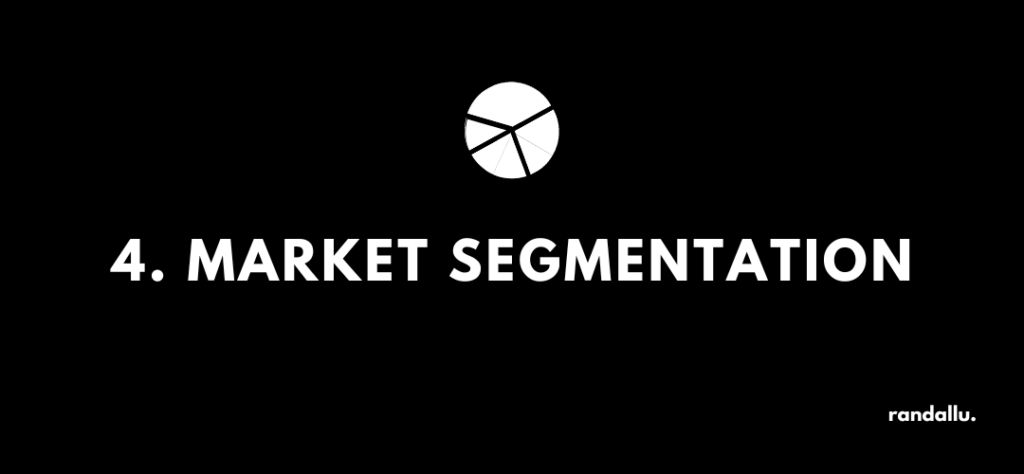
Segmentation involves grouping your customers based on similar needs or characteristics. By doing this, you can better understand your target audience and what drives their purchasing decisions. It can include things like demographics, psychology, behavior, and location. By understanding your market segments, you to create more effective marketing strategies and connect with your customers on a more personal level.
In B2B market research, segmentation can be useful in several ways:
- Identifying customer needs – By segmenting the market, you can gain a better understanding of the specific needs and preferences of different customer groups. This can help you tailor your products and services to better meet the needs of each segment.
- Developing targeted marketing strategies – By understanding the unique characteristics and needs of each segment, you can develop marketing strategies that are tailored to the specific needs and preferences of each group. For example, you might use different marketing channels or messaging to reach different segments.
- Improving customer service – By understanding the needs and preferences of different segments, you can provide better customer service that is tailored to the specific needs of each group. For example, you could offer different support options or service levels to different segments based on their needs.
- Identifying new opportunities – By segmenting the market, you can identify new opportunities for growth and innovation. For example, they might identify an underserved segment that has unique needs that are not being met by existing products or services.
Market segmentation can be a useful tool in B2B market research because it allows you to gain a deeper understanding of your customers and develop more targeted strategies that better meet their needs.
5. Brand Research

How do your customers see your brand? With brand research, you’ll get a sense of how well-known your brand is and what people think of it. You’ll learn how loyal they are to it, and how often they recommend it to others. On top of that, you’ll know more about how widely it’s used and how it’s positioned compared to other brands; and what value it offers to consumers.
Brand research is all about making sure your brand is on the right track. And if it’s not, make the necessary adjustments to get it there.
Here are some ways in which brand research can be helpful:
- Identifying brand strengths and weaknesses – Brand research can help you identify the strengths and weaknesses of the brand in the eyes of customers. This information can be used to develop strategies for strengthening the brand and improving its reputation.
- Understanding customer perceptions – Brand research can provide insights into how customers perceive the brand and its products or services. This information can be used to develop marketing strategies that are better aligned with customer needs and preferences.
- Evaluating brand positioning – Brand research helps you to evaluate how your brand is positioned relative to the competition. This can provide insights into how to differentiate the brand and develop a unique value proposition.
- Guiding brand development – Brand research can provide insights into how to develop the brand and its products or services in a way that resonates with customers. This can help you create a more compelling brand identity and improve customer loyalty.
Brand research can be a valuable tool in market research because it provides insights into how customers perceive the brand and how it can be strengthened and differentiated in a competitive marketplace. By understanding the strengths and weaknesses of the brand and its products or services, you can make informed decisions about how to improve the brand and better meet customer needs.
6. Competitive Analysis
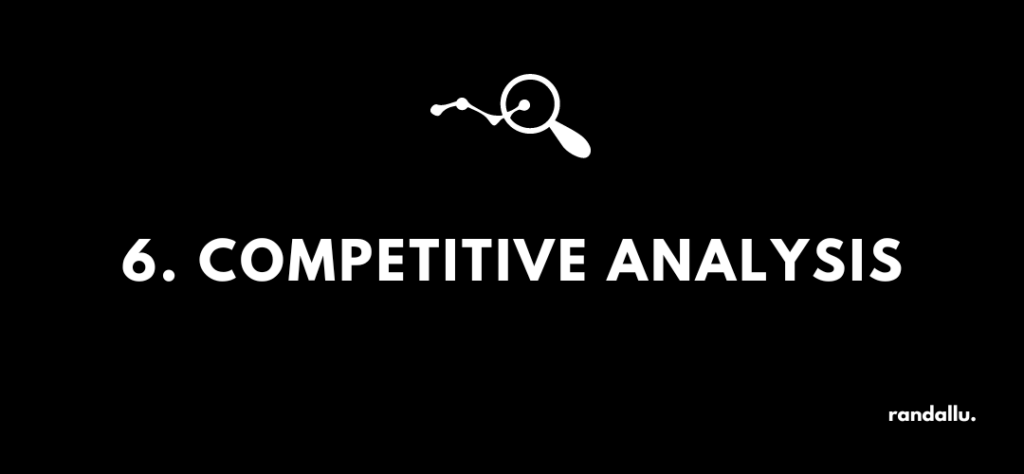
To stay ahead of your top competitors, you’ll want to perform an analysis so you can compare their strengths and weaknesses against yours. This means you can get a better understanding of their marketing tactics, sales approach, and distribution strategy. This can help you find areas for improvement that you can use to improve your own brand.
Competitive analysis can be helpful for:
- Understanding the competition – Competitive analysis helps you understand the strengths and weaknesses of your competitors, their marketing strategies, and their positioning in the market. This information can be used to identify areas of opportunity and develop strategies for differentiation.
- Identifying market gaps – Competitive analysis can help you identify gaps in the market that your competitors are missing. This information can be used to develop new products or services that fill these gaps and meet the needs of underserved customer segments.
- Evaluating pricing strategies – Competitive analysis can provide insights into how competitors are pricing their products or services. This information can be used to develop pricing strategies that are competitive and aligned with customer needs and preferences.
- Developing marketing strategies – Competitive analysis can help you develop marketing strategies that are effective in a competitive marketplace. By understanding how competitors are positioning themselves and how they are communicating with customers, you can develop messaging and marketing tactics that resonate with your target audience.
- Identifying threats and opportunities – Competitive analysis can help you identify threats to your business, such as new competitors or changes in customer preferences. It can also help identify opportunities for growth and expansion.
Competitive analysis provides insights directly into your industry landscape and helps you make informed decisions about how to compete effectively in the marketplace. By understanding the strengths and weaknesses of your competitors and identifying areas of opportunity, you can develop strategies that improve your competitiveness in the market.
7. Advertising Testing

Advertising testing is the process of evaluating the effectiveness of an advertisement before it is launched. It is done to determine the impact of the ad on its target audience and to identify any weaknesses or areas for improvement. Advertising testing can include pre-testing ads with focus groups, online surveys, or other research methods to gain insights into consumer perceptions and preferences. The results of advertising testing can be used to make adjustments to the ad and ensure its success when it is launched to a wider audience.
Here are some examples of how advertising testing can be used in market research:
- Pre-testing ads – Measure the effectiveness of different ad concepts before they are launched. This can involve showing ads to a sample of customers or conducting focus groups to gather feedback on ad concepts. The feedback can be used to refine the ad concepts and improve their effectiveness.
- Testing ad elements – Evaluate the effectiveness of different ad elements, such as headlines, images, or calls to action. By testing these elements with a sample of customers, you can identify which elements are most effective and make changes to improve the ad’s overall effectiveness.
- Measuring ad recall – Measure how well customers remember your ads. By measuring ad recall, you can determine how effective your advertising is at getting its message across to customers and identify areas for improvement.
- Evaluating ad impact – Evaluate the impact of your ads on customer attitudes and behavior. By measuring changes in attitudes or behavior after exposure to an ad, you can determine the effectiveness of your advertising and make changes to improve their impact.
Advertising testing can be a useful tool in market research because it allows you to evaluate the effectiveness of advertising campaigns before they are launched. By gathering feedback and making changes based on that feedback, you can improve the effectiveness of your advertising and increase the chances of a successful campaign.
8. Customer Segmentation
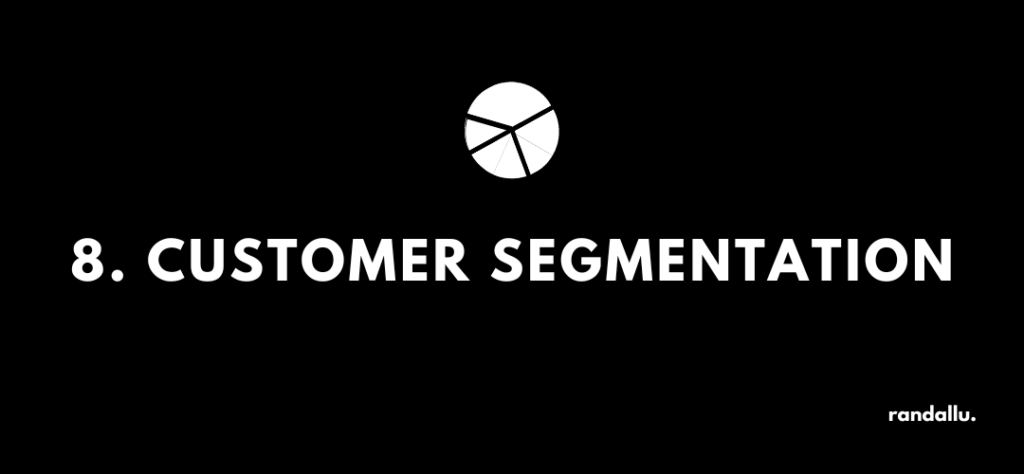
Customer segmentation involves dividing a target market into smaller groups based on shared characteristics or needs. This enables you to cater to the specific needs and preferences of each group by tailoring your marketing efforts. By analyzing various factors, such as demographics, psychographics, behavior, and geography, businesses can gain a more in-depth understanding of their customers and create targeted marketing strategies that resonate with them.
Customer segmentation can be helpful in several ways:
- Understanding customer needs – By segmenting customers based on their needs and preferences, you can gain a deeper understanding of what drives customer behavior and what factors are most important to each segment. This information can be used to tailor products and services to better meet the needs of each segment.
- Developing targeted marketing strategies – By segmenting customers based on their characteristics, you can develop targeted marketing strategies that are tailored to the specific needs and preferences of each segment. This can help you reach your target audience more effectively and improve your marketing ROI.
- Improving customer service – By understanding the unique needs and preferences of each segment, you can provide better customer service that is tailored to the specific needs of each group. This can help you build stronger relationships with customers and increase customer loyalty.
- Identifying new opportunities – By segmenting customers, you can identify new opportunities for growth and innovation. For example, they might identify an underserved segment that has unique needs that are not being met by existing products or services.
Segmenting customers allows you to gain a deeper understanding of your customers and develop more targeted strategies that better meet their needs. By understanding the unique needs and preferences of each segment, you can improve your products, marketing strategies, and customer service.
9. Pricing Research & Strategy

Pricing research and strategy involve studying the market to determine the ideal pricing for your products or services. The goal is to understand what customers are willing to pay and find the most effective pricing strategy that will drive sales and maximize profits. This process may include gathering information on competitors’ prices, customer demand, and market trends and using that data to make decisions about how to price your products or services.
Here are some examples of how pricing research and strategy can be helpful in market research:
- Determining optimal price points – Pricing research can help you identify the optimal price point for your products or services based on customer feedback and market data. By conducting pricing experiments or surveys, you can determine how much customers are willing to pay for their products or services, which can inform pricing strategies.
- Understanding price sensitivity – Pricing research can help you understand how sensitive customers are to changes in price. By measuring how customer demand changes in response to changes in price, you can determine the optimal pricing strategy for your products or services.
- Developing pricing strategies – Based on the insights gained from pricing research, you can develop pricing strategies that are aligned with customer needs and preferences. For example, they might develop dynamic pricing strategies that adjust prices based on changes in customer demand or develop pricing models that emphasize value or convenience.
- Differentiating from competitors – Pricing research can help you identify how your prices compare to those of competitors and identify areas where they can differentiate themselves based on pricing strategies. For example, they might offer lower prices for high-quality products or services, or offer pricing models that are more flexible or transparent than those of competitors.
Pricing strategy helps you better understand customer needs and preferences and develop pricing strategies that are aligned with those needs. With effective pricing strategies, you can improve your overall competitiveness.
10. Customer Satisfaction & Loyalty
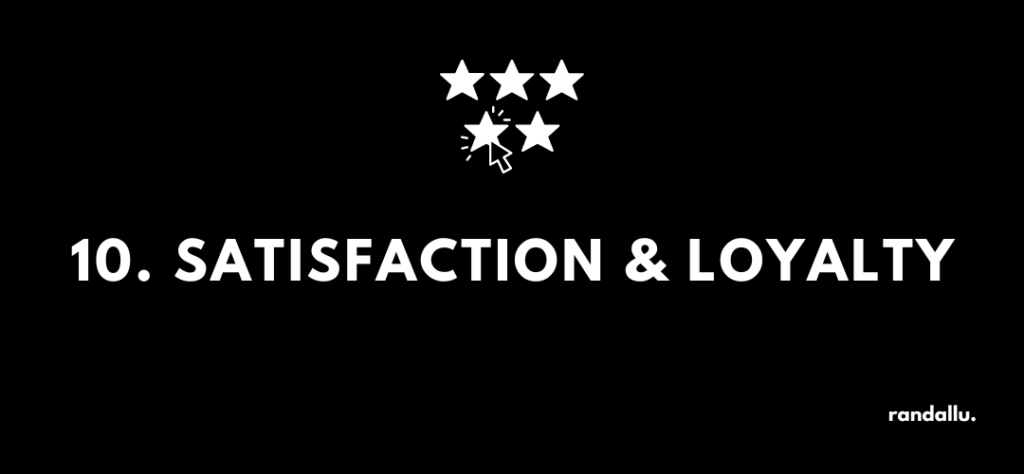
Understanding customer satisfaction and loyalty is an important aspect of market research. By knowing what your customers like and dislike about your business, you can make adjustments and minimize your risk. This type of research shows customer perceptions of your brand and can help you to retain loyal customers while also helping to attract new ones.
Here are some common ways to measure customer satisfaction and loyalty:
- Customer satisfaction surveys – These surveys can be used to gather feedback on customer experiences and satisfaction levels. They can be conducted through phone interviews, online surveys, or email. Questions can be open-ended or multiple-choice and can cover various topics such as product quality, customer service, and overall satisfaction.
- Net Promoter Score (NPS) – The NPS is a customer loyalty metric that measures the likelihood of customers recommending a business to others. Customers are asked to rate on a scale of 0 to 10 how likely they are to recommend the company. Customers who score 9 or 10 are considered promoters, those who score 7 or 8 are considered passive, and those who score 6 or below are considered detractors.
- Customer retention rate – This metric measures the percentage of customers who continue to do business with a company over a period of time. A high customer retention rate indicates customer satisfaction and loyalty.
- Customer feedback platforms – These are tools that allow customers to leave feedback, ratings, and reviews of your products and services. Examples of such platforms include Google Reviews, Social Media Mentions, Trustpilot Reviews, and G2 Crowd Reviews. These platforms can be useful in identifying areas of improvement and understanding customer sentiment.
- Customer success metrics – These metrics measure the success of customers using your products or services. They can include metrics such as time to value, adoption rate, and product usage. High success metrics indicate satisfied and loyal customers.
Measuring customer satisfaction and loyalty is critical for B2B companies to identify areas of improvement and maintain strong relationships with customers. Using a combination of these methods, you can gather valuable feedback and insights that can help improve customer satisfaction and loyalty.
11. Product Testing
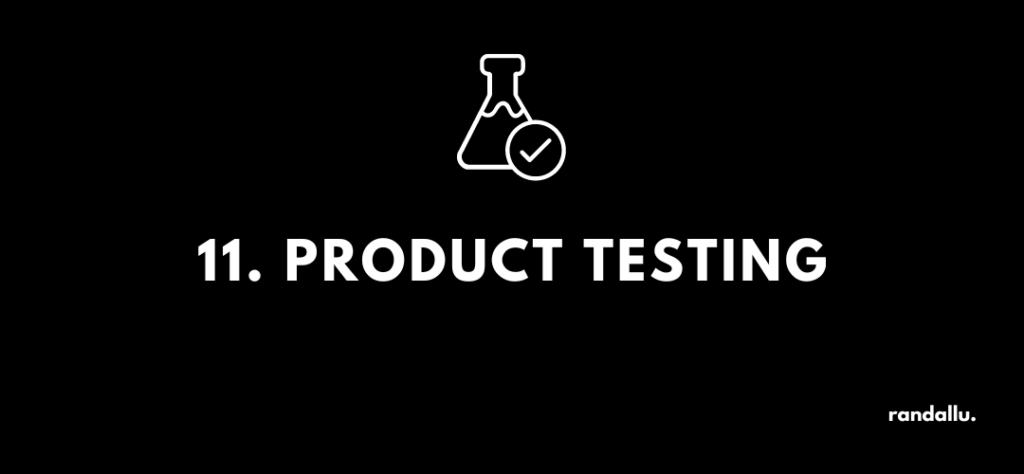
Product testing is a shared step between product development and market research teams. It helps to ensure that your new product or service has all the necessary components to be successful once it’s launched. By testing a product before it goes to market, you can identify gaps and make the necessary adjustments. This helps to minimize the risk of failure and increase the chances of success for the product.
Here are some ways in which product testing can help guide market research efforts:
- Identifying product flaws – Product testing can help identify flaws or defects in a product that may not be apparent through other research methods. By testing the product with a sample of customers, you can gather feedback on product features, usability, and overall satisfaction, which can inform product development and improve the product before it is launched.
- Understanding customer needs – Product testing can provide insights into customer needs and preferences by measuring how customers interact with the product and what features they find most useful. This information can be used to tailor product features to better meet customer needs and preferences.
- Evaluating product performance – Product testing can provide data on product performance, such as durability, reliability, and safety. This information can be used to make improvements to the product before it is launched, which can improve customer satisfaction and loyalty.
- Testing pricing strategies – Product testing can help you determine the optimal price point for your products. By testing different price points with a sample of customers, you can determine how much customers are willing to pay for the product and develop pricing strategies that are aligned with customer needs and preferences.
Product testing provides insights into customer needs and preferences, identifies areas for improvement, and helps you develop products that better meet the needs of your target audience. Using product testing along with other market research methods helps teams make informed decisions about product development, marketing strategies, and pricing strategies.
12. Focus Groups
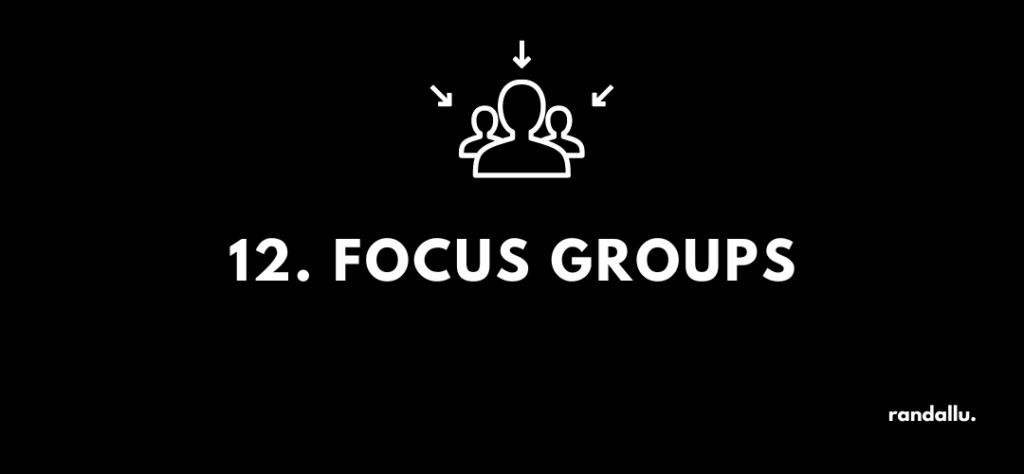
Focus groups are a great way for you to gather information about your target audience by bringing together a small group of people who fit the target market. In these groups, participants are asked questions about their thoughts and opinions on your product or service. This type of research can help you better understand what your customers think and make adjustments to better meet their needs.
Some examples of focus group scenarios that can aid market research efforts:
- Product design feedback – A focus group can be used to gather feedback on a product design before it is launched. Participants can be shown mockups or prototypes of the product and asked to provide feedback on its design, functionality, and usability. This information can be used to make improvements to the product design before it is launched.
- Brand perception and messaging – A focus group can be used to gather feedback on a brand’s messaging and perception. Participants can be shown different marketing materials, such as ads or product packaging, and asked to provide feedback on their messaging and effectiveness. This information can be used to refine the brand’s messaging and improve its effectiveness in the marketplace.
- Customer needs and preferences – A focus group can be used to gather insights into customer needs and preferences. Participants can be asked about their current experiences with a product or service, what features they find most important, and what improvements they would like to see. This information can be used to develop products and services that better meet the needs of customers.
- Pricing strategies – A focus group can be used to gather feedback on pricing strategies for a product or service. Participants can be shown different pricing models and asked to provide feedback on what they would be willing to pay for the product or service. This information can be used to develop pricing strategies that are aligned with customer needs and preferences.
Focus groups provide a forum for gathering detailed feedback and insights from a small group of participants and help guide product design, brand messaging, customer needs, and pricing strategies.
Benefits Of Market Research
Market research has several benefits for businesses of all sizes, including:
- Improved decision-making by providing insights into the target market and competition
- Enhanced customer understanding, leading to tailored and more effective marketing strategies
- Increased product and service success by identifying gaps and making improvements before the launch
- More informed pricing strategy, a better understanding of market value for products/services
- Better customer satisfaction and loyalty by addressing likes/dislikes and mitigating risks
- Lower risks and costs by avoiding costly mistakes in product development and marketing.
Summary
Market research is crucial for the success of businesses. It provides valuable insights into your target market and customers, allowing you to enhance your products and services, boost revenue and achieve overall growth. Three popular methods for conducting market research are surveys and polls, in-depth interviews, and dividing your market into smaller segments. Adopting these research methods can give you a competitive advantage and help you make well-informed decisions for sustained success.